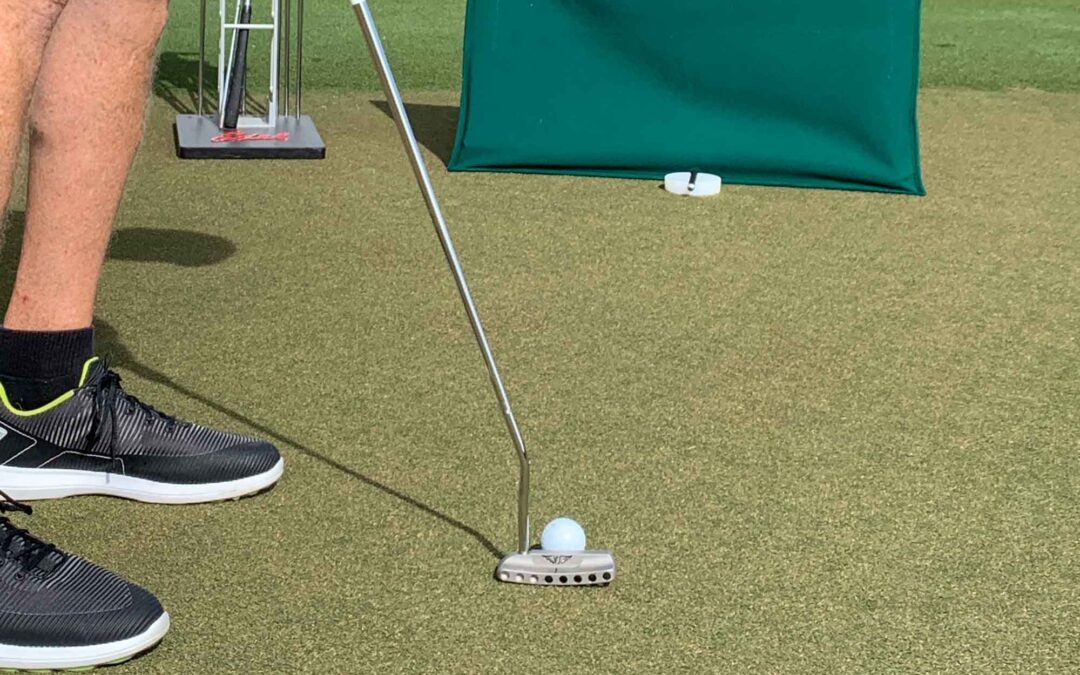From 2021 Oaks Magazine:
Two years ago I wanted to learn more about putter fitting. Everyone told me I needed to get a SAM PUTT LAB , a computerized putter stroke analyzer, top of the line, a great piece of equipment, but not my style. So I did some research and made some phone calls and within a week I was on a flight to Austin Texas to be trained to fit Edel putters. I was able to meet David Edel the owner and developer of the Edel company. He is an engineer by trade , member of the PGA and a very smart man. I went through their training and I got my wish “ I got to learn a lot about Putter fitting.
How is your putting?
We use our putter 41.3 percent of the time during our round of golf (including from the fringe). The average golfer takes 34 strokes with their putter during that time. There are all kinds of putters on the market today, Blade style, Mid-Blade, Mallet, and Hybrids (bigger heads, different shapes, large aiming lines). The total assembled weight of a putter on average is around 500 grams. On a fifteen foot putt, the club head is traveling 1510 mm/s (3mph) and the ball is on the putter face for less than a millisecond. According to the rules of golf : When the club head is in its normal address position, the dimensions of the head must be such that.
A. The distance from the heel to the toe is greater than the distance from the face to the back.
B. The distance from the heel to the toe of the head is less than or equal to 7 inches (177.8 mm)
C. The distance from the heel to the toe of the face is greater than or equal to two thirds of the distance from the face to the back of the head.
Confused yet? I am, glad I don’t have to make putters!
Which putter is right for you?
I can tell you right now plain and simple “The one you aim the best”, but of course like every other club in your bag, you still have to like the way it looks and feels but aiming is the number one factor. What effects aim? First let me tell you that everyone has a aim bias of some sort. The definition of Aim Bias— “a tendency or inclination to align the putter face in a direction other than that which is intended”. Here is what aim bias can create:
A. Aim bias creates path bias or the way you swing your putter.
B. Aim bias creates face rotation during your swing.
C. Aim bias affects green reading
D. Aim bias creates CONFUSION!
So what is the answer to Aim bias? You have to find a putter that you can aim even with your aim bias. I fit a gentlemen a year ago for a putter, we tried about 10 different putters each with its own combination of aiming lines and head styles. This gentleman apparently had an aim bias to lines on his putter which made the putter look closed. Each time we had him aiming at the target with the laser he would aim way right to compensate for it looking closed. So I set him up with a putter that had a dot on the top, no lines, he aimed perfectly straight! Here are a few putter specifications that can help you with your aim bias:
A. Blade style putters tend to look open so you tend to compensate and aim left, mallet style is just the opposite.
B. Hosel Design (the part of the shaft that attaches to the head) the more offset the more left the putter will aim.
C. Aim Line combinations, no lines tends to influence aim to the right, multiple lines tend to influence aim to the left.
D. One top line can change aim 1-3 inches left or right, where one bottom line can change aim 3-5 inch left or right.
Speed or Distance control
The next phase to finding the correct putter for you is speed control. Our hands are our scales, and relate sensory information to the brain about the weight of objects (putter in this case) and the pressure necessary to control its movement. Weight alters these pressure patterns in the hands to override the brains perception of how fast the putter is moving. So the way to alter the putter for each individual’s putter swing is either by head weight or weight in the grip end of the putter, and your swing will dictate where the weight needs to go. As green speeds have increased putters have become heavier over time and getting the right balance between head and grip is important and is based on your putter stroke. There is two different grip weight, one being counter balance normally at the end of the grip and the other is internal shaft weight.
A. Counter balance weighting has unique properties to the motion and sensations during the stroke and it also reduces swing weight.
B. Internal shaft weighting (Opti-Vibe) provides the fitter a way to change weight further down the shaft and in the hands, it also reduces swing weight or head weight. It will change follow-through position during the putter stroke depending where the weights go, lower or higher.
Your Body type and putting
Knowing this information is extremely important to putting, it is based off of Mike Adams’s Bio Screening process and is included in the new Edel putting system that we are getting soon. It includes :
A. Your arm length differentials between your upper and lower arm.
Measured from your right knuckle to your elbow and from your elbow to your humeral head of your shoulder of your trail arm. Each one of those will have a number related to it. (15-16 inches) Depending on the arm part that is the longest will determine what slot or path your stroke should be on.
The upper path is the Shoulder slot, next is the Torso slot and last is the hip slot. The longer your lower arm is to your upper arm the more vertical your slot will be (shoulder slot). If both measurements are the same then your slot would be the torso slot and if the upper arm is longer than your lower arm the slot would be the hip slot. These would help determine your path to swing on with your putter. Most people are in the wrong “Slot” and would explain why many players putter plane is too flat and and their arms are too close to the body or too far away based off of the slot they are supposed to be in.
B. Your arm span related to your height.
Measuring your arms straight out (like you were flying) finger tip to finger tip and compare that to your height . If you arm span is longer you need to be more vertical in our posture.
To get the correct posture touch your finger tips to the top of your kneecaps and that should be your posture. That will affect your putter lie degree and the putter length.
C. Your fold patterns/ arms held relaxed by your side.
Putting your right and left hands together with the right hand sticking out (one digit of your right hand middle finger above the left middle finger) past your left hand. (Opposite for left handers) Take your right arm back (like your golf swing) Left arm across your chest, But not moving your chest at all and look at where the elbow and hand face. This dictates how we grip the putter.
Also holding your arms relaxed by your side will help to determine your grip position as well.
Finding the right slot, standing in the correct posture and putting your hands on the putter correctly ensures that the face is not rotating. So fitting to the correct aim, and the correct weighting is an amazing process, but adding the body type characteristics to the fitting completes the picture of a great putt. We should be getting the new Edel fitting system with the body type information soon. I looks forward to working with you on your putter.
Take care,
Stan

